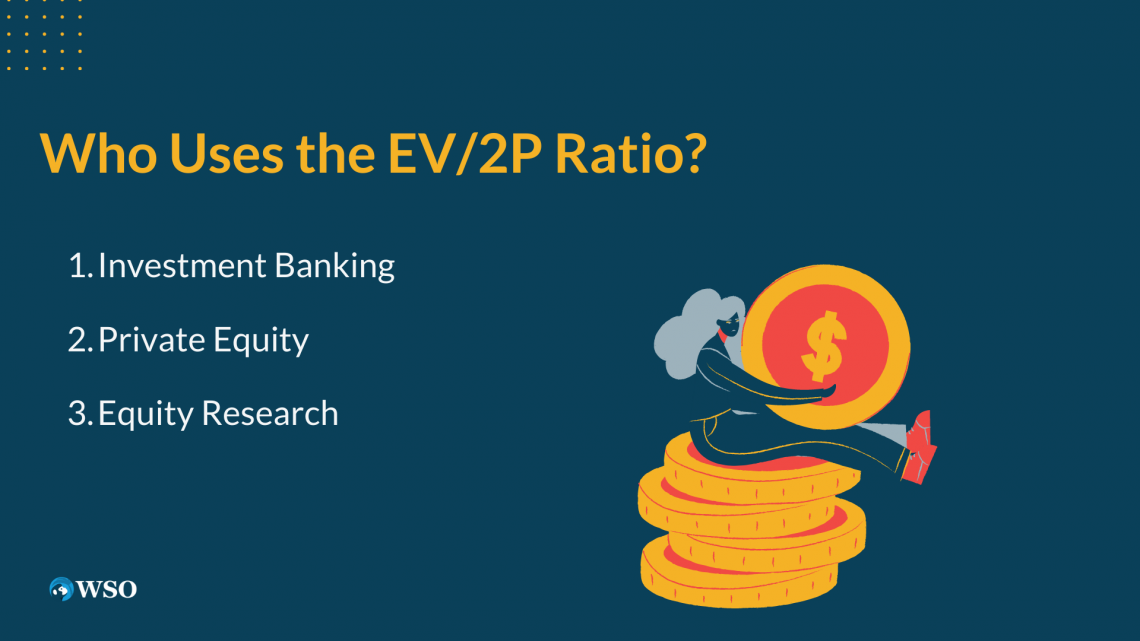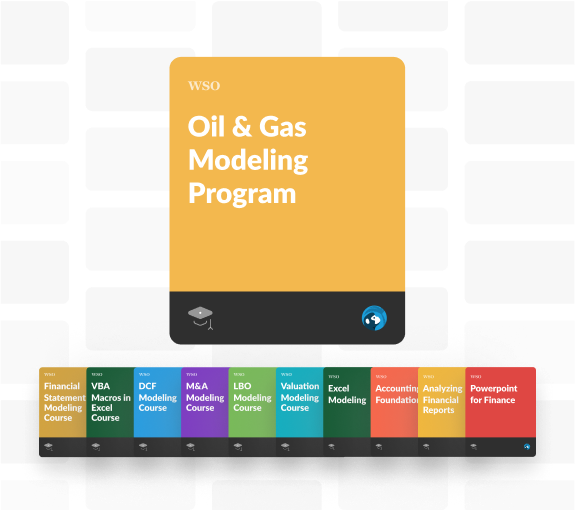EV/2P Ratio
The EV/2P ratio compares a company's enterprise value and proven and probable reserves to extract a multiple.
What is the EV/2P Ratio?
An EV/2P Ratio is a valuation multiple used to evaluate oil and gas companies. This ratio can be applied to both public and private companies, as it is derived from the assets and liabilities of a company’s balance sheet.

The Enterprise Value (EV) represents the comprehensive value of a company. Instead of looking at a company's market value, EV can be used to measure the total cost of purchasing a company outright by accounting for financing costs and subtracting total cash.
Proven and Probable (2P) represents the sum of reserves accessible by the company with a 50% or higher probability of being recovered. It is useful to compare corporations' growth and production potential to their assets, similar to EBITDA.
When valuing a business, the price-to-earnings (P/E) ratio and price-to-book (P/B) ratio are two ratios commonly referenced by investors and institutional analysts.
They provide a quick insight into the structure of a company but contain two major shortcomings compared to EV/2P:
- Does not account for growth prospects: The P/E and P/B valuation metrics do not account for the year-over-year growth of a company or its growth in margins compared to competitors. While a high P/E company may look unattractive on its own, higher growth prospects could make it a more appealing investment.
- Does not account for debt carried by the company: Both ratios purely account for the market cap and financial performance of related companies without keeping track of liabilities.
The EV/2P valuation metric fixes this by using enterprise value instead of the share price. This gives the investor a fuller picture of the financial status of a company by being able to compare business profitability with their respective financial statuses.
Key Takeaways
- The EV/2P ratio compares a company's enterprise value and proven and probable reserves to extract a multiple.
- The multiple allows a company to be compared to other companies in the oil and gas sector to measure their growth prospects.
- The ratio demonstrates the relative value placed on a company by investors by revealing a premium or discount to its competitors.
- Similar to the P/E ratio, the EV/2P ratio is used by individual and institutional investors and investment professionals in various fields.
What is Enterprise Value (EV)?
EV is considered a much more accurate representation of a firm’s value than market capitalization. It shows a company’s total value beyond pure equity and demonstrates how much money a business would need to purchase a given company outright.

The formula for an enterprise value (EV) is:
EV = Market Capitalization + Total Debt - Cash and Cash Equivalents
Cash is subtracted from enterprise value to display only the value of business assets and liabilities.
Suppose Apple were to purchase a company with a $500 million market cap and an enterprise value of $400 million; they would receive $100 million back from the purchase in the form of cash and cash equivalents. This is the logic behind subtracting cash from EV.
While this is a very simplified equation for enterprise value, an extended version would include the following:
EV = Market Value of Preferred/ Common Shares + Long-term and Short-term Debt + Market Value of Minority Interest* + Pension Liabilities and Other Debt Provisions - Value of Associate Companies - Cash and Cash Equivalents
* Minority Interest = Value of equity holdings with lower than 50% ownership of a company.
Although EV has many advantages over other valuation methods, the data may still be unreliable in certain circumstances. During periods of volatility in interest rates, EV can swing by large amounts in very short periods.
Another weakness of EV is due to the possible illiquidity of a company’s bonds in the secondary market. Although this usually is not an issue for large corporations, low-volume bonds of smaller companies may not display the most accurate prices, skewing the data used in an EV multiple.

EV also fails to consider debt usage between companies from different sectors. For example, it is difficult to compare telecom and utility companies to software companies due to the capital-intensive nature of those two businesses.
The metric is better suited to compare companies in the same sector and growth phase to better understand how efficiently a company uses its capital.
Understanding the EV/2P Ratio
Now that we understand Enterprise Value, we can dive into the specifics of using the EV/2P ratio.

The EV/2P ratio is calculated as such:
EV/2P = Enterprise Value / Total proven and probable reserves
As mentioned previously, proven and probable reserves are the sum of a company’s available resources to be used in its growth and operations.
Similar to a P/E or EV/EBITDA ratio, the EV/2P ratio is used to calculate the valuation of an oil and gas company’s assets and prospective growth relative to other companies in the sector.
A high ratio means the company is trading at a premium, whereas companies with a low ratio are trading at a discount compared to competitors. The ratio can also be compared to historical averages, signaling whether the company is over or undervalued at present.
Here is an EV/2P ratio using the metrics of an example company. This assumes an enterprise value of $10 billion and $1 billion of proven and probable reserves.
EV/2P = $10 Billion / $1 Billion = 10.0x
This company has a multiple of 10. Although the ratio does not mean much purely on its own, the ratio gains value when compared to competitors and other companies in the sector with similar assets and growth prospects.
Note
Investors may reconsider investing in a company due to a high valuation, but it is important to consider all other business factors, not just the EV/2P ratio.
Some companies may have a higher ratio than competitors due to:
- A better financial track record over a long period of time
- A greater operational efficiency or return on equity compared to competitors
- Greater growth prospects, such as due to technological or geographical advantages
When valuing a company, one ratio is not the end all be all of an investment. While a company may look over or undervalued on the surface, considering all of the advantages and disadvantages inherent to each business is essential to building a solid thesis.
Comparison of EV/2P and EV/EBITDA
Both the EV/2P and EV/EBITDA ratios are similar because they are a relative measure of the valuation of oil and gas companies. However, the two ratios compare a company's value over a different time range.

EBITDA stands for earnings before interest, taxes, depreciation, and amortization. In simpler terms, it measures a company’s earnings without adjustments that would otherwise change net income.
EV/EBITDA is the consolidation of both enterprise value and EBITDA. The metric strips away misleading or unnecessary value indicators, such as cash reserves and adjustments to income due to depreciating equipment, to give an investor the true value of buying the company.
While EV/EBITDA is useful for calculating the current value of a company’s profitability compared to competitors, the EV/2P ratio is an excellent addition to measure the future value of a company’s cash flows and its ability to grow its EV/EBITDA over time.

For example, let’s analyze two example oil and gas companies to practice using these metrics, Exxon Mobil (NYSE: XOM) and Devon Energy (NYSE: DVN).
Exxon Mobil is an established oil giant that has been listed and increasing its dividend for over 40 years. The company has an EV of $441.56 billion and an EBITDA of $102.6 billion as of December 2022. Its proven and probable reserves total over 66.8 billion barrels (Pg 7).
On the other hand, Devon Energy is a high-yielding oil and gas company that only originally traded in 1988. The company has an EV of $37.75 billion and an EBITDA of nearly $10.2 billion as of December 2022. Its proven and probable reserves total nearly 6.3 billion barrels (Pg 94).*
* = Statistics as of Q1 2023
Let’s compare both companies by their EV/EBITDA and EV/2P valuations. See the math below:
EV/EBITDA (in thousands)
Exxon Mobil: 441,560,000 / 102,600,000 = 4.30x
Devon Energy: 37,750,000 / 10,200,000 = 3.70x
EV/2P (in thousands)
Exxon Mobil: 441,560,000 / 66,800,000 = 6.61x
Devon Energy: 37,750,000 / 6,300,000 = 5.99x
According to these valuations, Exxon Mobil is trading at about a 16% premium to Devon in terms of EV/EBITDA (4.30x / 3.70x) and a 10% premium to EV/2P (6.61x / 5.99x).
Perhaps this is a justified price difference due to Exxon’s longevity and continuous return in value to shareholders, or maybe the market is overconfident in Exxon’s ability to grow in the future. This is what you get to decide as an investor!
Who Uses the EV/2P Ratio?
The EV/2P ratio has many practical uses in career paths beyond analysis by individual investors and company executives.

Three financial careers that use the multiple in various due diligence are as follows.
Investment Banking
Investment bankers are responsible for bringing companies to the open market through an Initial Public Offering (IPO). The investment bank's main functions are to build an order book for public issues and determine the client company's fair value.
Investment bankers use three core principles to determine the value of a company compared to direct competitors. These are:
- The Discounted Cash Flow Model (DCF)
- Multiples Analysis
- Comparable Transactions Analysis

The DCF model is essential for valuing companies inside of M&A transactions. The Wall Street Oasis DCF Modeling Course is an excellent resource created by industry experts to learn more about fundamental valuation and a career as an investment banker.
Inside of multiple analysis, the EV/2P ratio is used with a slew of other ratios to directly compare an oil and gas company’s financials compared to other companies in the industry.
The underwriting investment bank can use multiple analysis in conjunction with additional information provided by the company to determine an offering price. This price is usually lower than the estimated market value to ensure the entire issuance is sold to investors.
Comparable Transactions Analysis allows the investment bank to discover what prices similarly valued companies were sold at in the open market. These evaluations can be compared to internal fundamental valuations, such as a DCF, to determine a reasonable asking price.
Private Equity
Private equity firms use the same types of valuation metrics but for different reasons. While investment bankers are focused on evaluating companies for listing on public markets, private equity firms work to estimate an offer price to take a target company private.

Along with the previously stated metrics, private equity associates use basic ratios such as P/E, P/B, EV/2P, EV/EBITDA, and most importantly, price to free cash flow (P/FCF).
The P/FCF ratio is a large focus for private equity firms due to measuring a business’s ability to pay off a sizable amount of debt over time, such as in a leveraged buyout (LBO).
More details about the private equity modeling process can be found in the Wall Street Oasis LBO Modeling Course.
Equity Research
Equity research analysts use various methods in addition to the previously mentioned ones.

When analyzing a slow-growing or troubled business, analysts simply measure the asset value of a company by subtracting assets from liabilities. Looking at book value also allows analysts to compare a previous transaction price to a slow-growing company.
Analysts use the EV/2P ratio to set a target price for companies in the oil and gas industry. They can use the data to set a rating on a company, create a thesis, and recommend action on whether to buy, hold, or sell the stock.
The information provided by equity research analysts is not definitive or guaranteed, but it is notable for investors to keep analyst opinions in mind to compare to their theses and to ensure their expectations for a company are reasonable.




or Want to Sign up with your social account?